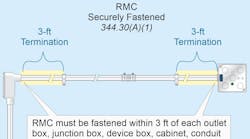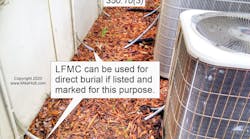Q. What are the Code rules for sizing overcurrent protection for conductors?
A. Except as permitted by (A) through (G), conductors must be protected against overcurrent in accordance with their ampacity after ampacity correction and adjustment as specified in Sec. 310.15 [240.4].
(A) Power loss hazard. Conductor overload protection isn’t required, but short-circuit protection is required where the interruption of the circuit will create a hazard; such as in a material-handling electromagnet circuit or fire pump circuit.
(B) Overcurrent devices rated 800A or less. The next higher standard rating of overcurrent device listed in 240.6 (above the ampacity of the ungrounded conductors being protected) is permitted, provided all of the following conditions are met:
(1) The conductors aren’t part of a branch circuit supplying more than one receptacle for cord-and-plug-connected loads.
(2) The ampacity of a conductor, after the application of ambient temperature correction [310.15(B)(2)(a)], conductor bundling adjustment [310.15(B)(3)(a)], or both, doesn’t correspond with the standard rating of a fuse or circuit breaker in 240.6(A).
(3) The overcurrent device rating doesn’t exceed 800A.
Note: This “next-size-up” rule doesn’t apply to feeder tap conductors [240.21(B)] or transformer secondary conductors [240.21(C)].
(C) Overcurrent devices rated over 800A. If the circuit’s overcurrent device exceeds 800A, the conductor ampacity, after the application of ambient temperature correction [310.15(B)(2)(a)], conductor bundling adjustment [310.15(B)(3)(a)], or both, must have a rating of not less than the rating of the overcurrent device defined in Sec. 240.6.
(D) Small conductors. Unless specifically permitted in Sec. 240.4(E) or (G), overcurrent protection must not exceed the following:
(1) 18 AWG copper — 7A
(2) 16 AWG copper — 10A
(3) 14 AWG copper — 15A
(4) 12 AWG aluminum/copper-clad aluminum — 15A
(5) 12 AWG copper — 20A
(6) 10 AWG aluminum/copper-clad aluminum — 25A
(7) 10 AWG copper — 30A
(E) Tap conductors. Tap conductors must be protected against overcurrent as follows:
(1) Household ranges and cooking appliances and other loads [210.19(A)(3) and (4)]
(2) Fixture wire [240.5(B)(2)]
(3) Location in circuit [240.21]
(4) Reduction in ampacity size of busway [368.17(B)]
(5) Feeder or branch circuits (busway taps) [368.17(C)]
(6) Single motor taps [430.53(D)]
(F) Transformer secondary conductors. The primary overcurrent device sized in accordance with Sec. 450.3(B) is considered suitable to protect the secondary conductors of a 2-wire (single voltage) system, provided the primary overcurrent device doesn’t exceed the value determined by multiplying the secondary conductor ampacity by the secondary-to-primary transformer voltage ratio.
(G) Overcurrent protection for specific applications. Overcurrent protection for specific equipment and conductors must comply with the requirements referenced in Table 240.4(G). For example, air-conditioning and refrigeration equipment, and their circuit conductors, must be protected against overcurrent in accordance with Sec. 440.22. Note: Typically, the branch-circuit ampacity and protection size is marked on the equipment nameplate [440.4(A)].
Air-conditioning and refrigeration nameplate values are calculated by the manufacturer according to the following:
- Branch-circuit conductor size [440.32]
- Branch-circuit protection size [440.22(A) and 240.6(A)]
- Motors [Article 430]. Motor circuit conductors must be protected against short circuits and ground faults in accordance with Sec. 430.52 and Sec. 430.62 [430.51].
If the nameplate calls for fuses, then fuses must be used to comply with the manufacturer’s instructions [110.3(B)].
As noted in Art. 430, motor control circuit conductors must be sized and protected in accordance with Sec. 430.72.
Let’s run through an example problem to show you how to calculate protection for a specific application.
Example: What size branch-circuit conductor and overcurrent device (circuit breaker) is required for a 7½-hp, 230V, 3-phase motor with 75°C terminals?
Step 1: Determine the branch-circuit conductor size [Table 310.15(B)(16), 430.22, and Table 430.250]:
FLC = 22A [Table 430.250]
22A × 1.25 = 28A, 10 AWG, rated 35A at 75°C
Step 2: Determine the branch-circuit protection size [240.6(A), 430.52(C)(1) Ex. 1, and Table 430.250].
Inverse time breaker: 22A × 2.50 = 55A
Next size up = 60A.
These materials are provided to us by Mike Holt Enterprises in Leesburg, Fla. To view Code training materials offered by this company, visit www.mikeholt.com/code





